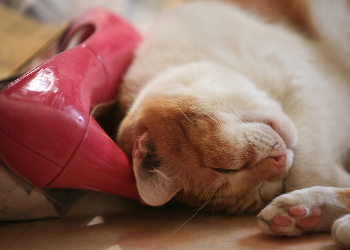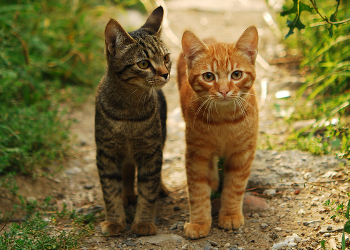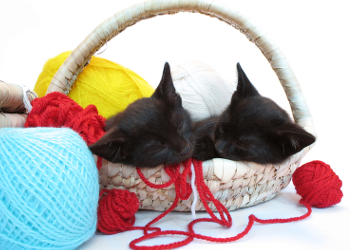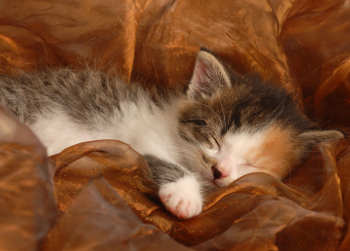Diseases #13

False pregnancy (also known as pseudopregnancy) is very common in canines but not so in cats. It is caused by a hormone inbalance. The suspect hormone is progesterone, a hormone needed for maintenance of pregnancy but in excess can also lead to pyometra.
False pregnancies almost always occur about a month after the intact female was in heat; yet she had not mated with a male dog. Hormonal changes in the dogs body cause about 100% of all the clinical signs seen.
Most people presenting a dog for false pregnancy are flabbergasted to say the least. They swear up and down that their dog did not "get caught". I usually told them that this happens and it isn't the clients fault! The clinical signs associated are those very similar to a female about ready to deliver her pups! The dog may: have breast enlargement and often start to lactate (very common), start to pace and become anxious, make a nesting place for her "phantom pups" and actually go into labor in some rare instances!
Lab work includes a CBC and Chemistry profile plus a vaginal smear to be stained and examined under the microscope. Radiographs may be taken to MAKE SURE MISTAKES are not made. People reading this would never believe the things I have heard or seen in my 33 year long career! I have had people swear to me on a stack of Bibles that the dog was not impregnated. Close to 2 months from the time the dog was in heat, the animal is presented for (at least it looked like it from the history) false pregnancy. Low and behold, a lateral radiograph showed a bunch of fetal skeletons in the uterus. You get the point! Always make sure the dog is not pregnant!
Diagnosis is easily made by the history obtained and a dog that was in estrous 1-2 months prior to presentation. Lab Work and radiographs will rule out pregnancies and the like.
There is no specific therapy for pseudopregnancy as the clinical signs will subside over time. If it is a breeding animal, the dog is fully capable of being mated in the future.
If the dog is not to be bred, it is ultra important that all dogs going through a false pregnancy be spayed. Going through false pregnancies increases the risk of developing breast cancer in the dog. Progesterone excess (one of the causes) can cause a female to develop pyometra; a severe uterine infection requiring an emergency ovariohysterectomy.
The prognosis for false pregnancy is excellent. Prevention of future episodes of this condition and other gynecological problems can be totally avoided by having the animal spayed.

Feline Immunodeficiency Virus (FIV) is a debilitating virus of cats caused by a retrovirus. It is in the same class as Feline Leukemia.
The FIV attacks the immune system of the cat weakening it in the process. This makes the animal much more susceptible to any future infection. It is very commonly seen in male tom cats plus cats that live outdoors. The mode of transmission is primarily through bite wounds from cat to cat. Retroviruses are species specific. The cat virus does not cause disease in dogs or humans.
The cat goes through several stages of disease: acute, subacute and chronic. Throughout all of these stages, the immune system gets weakened even further. By the time the cat is in the chronic phase, bacteria and or viruses that rarely cause trouble in a healthy cat, can be fatal. The immune system has literally been torn to shreds.
The clinical signs associated with FIV are varied. The entire immune system is deficient so all body systems can be affected by the virus. One of the most common signs seen in the cat are: a poor coat, anorexia and weight loss. These are general signs. A specific sign seen in at least half of all FIV cats is the presence of oral lesions. Severely infected gums (gingivitis), mouth (stomatitis) and severe dental disease are seen. Animals often lose weight due to the persistent diarrhea that exists. Chronic wasting and respiratory infections are seen as well.
A CBC and Chemistry profile will show altered values due to the organs affected by FIV. A conclusive test is available and most veterinarians use a combo Idexx® FIV/FeLV Snap Test. The clinical signs of both diseases are similar so it is wise to run both tests at the same time. There are some issues though:
1. The snap test detects antibodies to FIV. Young kittens may also test positive since their mother passes short term passive immunity to them via nursing. Retest every 60 days till they are about 6 months of age. Cats that are vaccinated against FIV will test positive since vaccine antibodies (at the moment) can not be differentiated from actual infection antibodies.
2. A negative snap test means there are no antibodies present and can be assumed to be free of the disease...except in those cats just exposed to the virus and tested, there will be no antibodies. Most diseases require at least 2 months to develop an effective humoral immune response.
No lab test is ever 100% effective one way or another.
Diagnosis is made by the associated batch of clinical signs that can be present plus by the history of the cat being male and living outdoors or completely feral. Even though their are interpretive problems with the snap test, it is highly effective in leading to a positive diagnosis when combined with other physical findings.
There is no actual direct treatment for FIV infections. If secondary infections are present, those need to be treated and fluid replacement and calories provided via Nutrical® or any other high calorie food. The goal in positive cats is to allow the animal to have a quality of life without exposing other cats to the disease. Sick cats should always be kept indoors and away from other animals. What if there are other cats in the household? It is risky. They can all be tested and vaccinated but no vaccine is perfect and there is a chance of exposure. That is a risk an owner will have to decide whether they are willing to try that approach. Sick cats have a completely demoralized immune system and can not handle any stress. Try to keep the environment as stress free as possible.
The prognosis of the disease varies with the organ systems that are effected plus the severity of the immune system degregation. If an FIV cat stabilizes it can live for many years as long as periodic medical exams and lab work are performed to assess bodily functions. Any other infectious disease or condition must be immediately treated. It is preferable not to introduce any other cats to the household at this time. The risk of exposure is too high. Prognosis becomes poor when an animal starts to lose tremendous amounts of weight over a short time and a worsening of its condition.
Prevention is the key with many diseases in the cat. Testing, testing and more testing. That is it in a nutshell. Without screening, it is impossible to know which cat is positive and which is negative. Screen all cats new to the household via adoption or a cat found as a stray. Many veterinarians test ANY sick cat that enters the practice. As I preached to my Ohio clients, keep the cat indoors!! When it comes to FIV, that is very good advice.

Feline Herpes Virus (FHV-1) is also known as Feline Viral Rhinotracheitis. It causes severe respiratory infections in cats; particularly in kittens.
Feline Herpes Virus is a tricky little bug. Like all Herpes viruses, a patient is never free of the virus. They may recover from the illness but the virus is always present. Herpes virus is a latent virus. It hides in neutrophils and other blood cells and effectively evades the immune system. Once the cat is stressed from some exogenous cause, the virus leaves its hiding place and pounces on the cat causing a repeat of respiratory signs.
Feline Herpes Virus is transmitted by direct contact from cat to cat by any nasal or eye secretion. Bedding and food bowls can be a source of contamination to susceptible cats. It is seen most commonly in places where there are large numbers of cats in close quarters such as shelters and catteries. Young kittens are at a higher risk since they have an immature immune system. The tricky part in cat exposure is the carrier cat. Those cats have a latent infection. They are not clinically ill but can easily transmit the virus to a susceptible cat.
Clinical signs in cats are always respiratory. Intense sneezing, coughing, nasal discharges, runny eyes and infected conjunctiva are all part of the disease process. A severe head cold! Animals will be anorexic and, like most sick cats, will just sit in one place for hours with their heads held down.
Veterinarians will initially draw a CBC and Chemistry profile to check bodily functions. Being a virus, herpes cats will often have a drop in their white cell count (leukopenia). Swabs of the nasal secretions or conjunctiva will be sent to the lab for culture and hence a definitive diagnosis. Chest films may be taken in case of severe respiratory infections.
Diagnosis of Feline Herpes Virus is made through a good history and physical exam. Many other viruses can mimic the FHV-1 virus. Conclusive diagnosis is made by culturing the virus in the lab.
There is no specific treatment for Feline Herpes Virus. Antibiotics are usually prescribed to prevent secondary bacterial infections. Nebulization therapy is also effective in clearing the respiratory tract of secretions making it easier for the cat to breathe. Topical ophthalmic antibiotics are usually prescribed to treat the bilateral conjunctivitis. L-Lysine (Viralys®) has been found to minimize the clinical signs associated with herpes virus by slowing down the intracellular replication of the herpes virus. L-Lysine is a nutritional supplement and comes in gel form for easy administration to the cat.
The prognosis for most Feline Herpes Virus patients is very good. Providing a stress free environment for the cat and high quality nutrition goes a long way in helping improve the life of the cat. It is a latent virus and can cause issues in the future.
Prevention is the key. Feline Viral Rhinotracheitis is one of the three diseases commonly vaccinated for in cats beginning at six weeks of age. No vaccine is perfect but this one is a good bet for all cats. The kitten needs to go through a complete series of shots than boostered once annually to maintain effective antibody levels to the disease.

Feline Infectious Peritonitis (FIP) is a severe, debilitating disease in cats. Young cats with an immature immune system are most commonly infected with the virus. FIP is a member of the cornona virus family. Corona viruses usually are associated with digestive clinical signs in the dog and cat but a cornona virus serotype was found to cause the clinical signs of FIP in the cat.
FIP is extremely contagious and passed easily from one cat to another from bodily fluids and or secretions. The disease exists in two forms:
1. Wet form: Usually seen in young kittens, this form is characterized by the accumulation of fluid within the abdominal cavity or thorax or both. Clinical signs will be related to the presence of fluids in these cavities.
2. Dry form: In this form, granulomas (scar tissue) are formed in various organs particularly the liver, lungs and spleen. Clinical signs are based on the location of the lesions. This form can be challanging to diagnose.
Clinical signs associated with the wet form of FIP is the presence of a distended abdomen and or labored breathing due to the presence of free fluid in the pleural space or abdominal cavity. Cats will often have respiratory signs or diarrhea that are non responsive to antibiotics. Cats become anorexic and lose weight rapidly. The dry form of the disease can be insidious. The cat may harbor the virus without any signs for years. They will act like nothing is wrong. When stressed the granulomas take their toll and cats will develop signs of liver disease such as weight loss and jaundice. The major problem with cats is that they can be deathly ill, and from an outward appearance, they feel like they have the world in their paws (they usually do anyway!). Stress comes along, than they crash. This makes it much harder to treat them because they are so far along when diagnosed.
An FIP ELISA (Enzyme Linked Immunosorbent Assay Test) exists but unfortunately it is unable to differentiate the intestinal version of corona virus from the FIP version of corona virus. All a positive test states is that the cat had been exposed to one or the other but will not tell you which one. A negative test can assume the cat is negative for both. The problem with that is, if the cat has just developed clinical signs it may be too early for an antibody response to be picked up hence giving a false negative. A CBC and Chemistry profile are always done plus a urinalysis to monitor bodily functions for an source of disease.
Diagnosis of the wet form is made by a history of exposure plus associated clinical signs. Tapping the abdomen will almost always produce a straw colored liquid that is sticky between the fingers. This is due to the protein content of the liquid. The dry form is extremely difficult to diagnose because of the varied signs seen that may mimic other disease processes. Even when suspected, there is no effective test to conclusively diagnose it. Therefore, FIP is usually a tentative diagnosis. It could be confirmed on tissue sample submission but by that time the cat is too weak and a poor anesthetic risk to do the procedure. Many cats are diagnosed post mortem.
There is no direct treatment that will neutralize the FIP virus. In the wet form, clinical signs develop so rapidly that most cats succumb within a week or two or less. Once the dry form manifests itself, it too is difficult to treat with supportive care. Supportive care can be attempted. This includes: fluid and calorie support and appetite stimulation with mirtazapine. Vitamins may also be given. In the end, you are just buying time and most cats are euthanized.
The prognosis for FIP cases is usually poor. There is no antiviral therapy and supportive care is iffy at best. There is a FIP vaccine that came out in the mid 1990's but its level of effectivity was initially poor. Only about 50%-60% of cats developed any benefit from the vaccine. I used it in my Ohio practice but was not impressed. It was an intranasal vaccine. I do not recommend its use.

Feline Leukemia is a severe viral disease in cats that plays havoc with its immune system. It is caused by a retrovirus and is often known as the AIDS virus of cats. Back in the early 1980's and before the FeLV vaccine, I would diagnose at least 5 cats every day with it. It was THAT common before vaccination became popular and highly effective.
Feline Leukemia (FeLV) is extremely contagious and is transmitted by bite wounds, nasal and fecal secretions and by sharing infected food & water dishes and litter boxes. It is not common in indoor cats but most commonly seen in catteries, shelters or feral cats. The sad thing is, is that the virus can be transmitted in utero to a queens unborn kittens. I have watched litters of kittens die after trying to get a start on life but only to succumb to the disease because the mother was a carrier. It is this carrier state that is dangerous. The cat will look and act clinically normal but be able to transmit the disease to other cats. FeLV is not transmissable to people and dogs. Once diagnosed with the disease, most cats almost never live more than 2-3 years longer. The disease is most commonly seen in young kittens up to about the age of 6. Older cats when exposed may ward off the virus due to a healthy immune response.
Clinical signs associated with FeLV are all related to the immune system decline seen in all cats. In some forms, the cat literally melts in front of your eyes. Signs of extreme weight loss and dehyration are common. Anemia and jaundice are common. The anemia is noticeable by the pale gums of the mouth and jaundice always starts around the soft palate of the oral cavity. Some animals may have persistent respiratory or digestive signs. Animals may have a persistent fever and enlarged lymph nodes. Some will have tumors related to the condition. Lots of cats show ZERO clinical signs and they are dangerous carriers of the disease. Once stressed with respiratory infections or facsimile, they too can demonstrate clinical signs. A pregnant queen can can be suspect of carrying the disease if her kittens soon die. FeLV is at the top of the list in so called "fading kitten syndrome diseases".
All sick cats should undergo a CBC and Chemistry profile for a minimal clinical database. Usually, a combo Idexx® FeLV/FIV Snap Test is performed. FIV mimics FeLV in many of its clinical signs, so it makes sense to run the combo test.
Diagnosis is usually made in a young cat demonstrating clinical signs of FeLV. These cats have not been vaccinated against the disease. Association with other cats in catteries, shelters or multi-cat households, where the disease is more common, is an important historical finding. The FeLV ELISA test confirms the diagnosis.
There is no direct treatment to eliminate the Feline Leukemia Virus. In homes with one infected cat, supportive care can be commenced which entails a high caloric diet and a multi-vitamin gel such as Nutrical® should always be offered. A handy trick is to mix Nutrical® together with Hill's® Prescription a/d food. This combination really packs a punch and definitely helps the cat.
The tricky question becomes what to do about a positive FeLV cat that is living with other cats in the household? On one hand, it is dangerous to have a positive cat around other healthy cats since the virus can be transmitted to the other cats. On the other hand, the positive cat may have been healthy and around the other cats for a long period of time. It is very possible and highly likely that the other cats were exposed to the virus and were able to fight it off due to a healthy immune response. What to do varies with each owner. Some owners will wish the positive cat put down while others want to provide supportive care. Ideally, the positive cat should be kept separate from the other cats. All of the remaining cats should be tested for the virus and if negative should all be vaccinated against FeLV. If a cat tests positive and is healthy, this is not a death sentence. That cat should be tested every 1-2 months and if the veterinarian gets two consecutive negative tests, the animal should be vaccinated for FeLV. Cats are fully capable of fighting off an infection.
Even with supportive care, the long term prognosis for FeLV cats is poor. Most cats rarely live longer than 3 years after the condition is diagnosed. It is heartbreaking to see these animals decline. Over the years, it has made practicing veterinary medicine very difficult at times.
The best approach is prevention. All cats that are taken home should be vaccinated and tested. Keep all cats indoors and away from any sick cat. If your one cat is vaccinated against FeLV and you want to get another cat, make sure a FeLV test has been performed and get the cat vaccinated. If you find a stray cat or buy a cat and you are unsure if the animal has been tested, DO NOT TAKE THE CAT HOME IMMEDIATELY. Take it to your veterinarian and get it tested. If negative than you can introduce the new cat. No vaccine is purrfect but it is known that a vaccinated cat is a safer, healthier cat in case it is every challenged by a positive FeLV animal.

